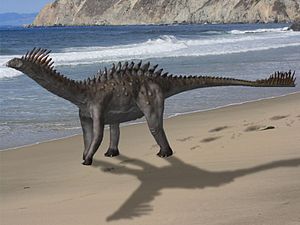Agustinia
| Agustinia Temporal range: Early Cretaceous,
| |
|---|---|

| |
| Scientific classification | |
| Kingdom: | |
| Phylum: | |
| Class: | |
| Superorder: | |
| Order: | |
| Suborder: | |
| Family: | |
| Genus: | Agustinia
|
| Species: | A. ligabuei
|
| Binomial name | |
| Agustinia ligabuei Bonaparte, 1999
| |
Agustinia (Template:Pron-en) is a genus of sauropod dinosaur from the Early Cretaceous Period of South America. Like all known sauropods, it was quadrupedal and herbivorous. Although some sauropods are known to have body armor, Agustinia's armor was unique even among sauropods. It had a series of wide, vertical spikes and plates down the center of its back, somewhat like the unrelated Stegosaurus. Aside from the armor, very little is known about the anatomy of Agustinia. A fibula (lower leg bone) has been recovered that is about 3 feet (895 mm) long. When compared to the same bone in related dinosaurs, this indicates that Agustinia may have been about 50 feet (15 meters) long.
The name Agustinia honors the discoverer of the specimen, Agustin Martinelli. This dinosaur was originally named in a 1998 abstract written by famous Argentine paleontologist Jose Bonaparte. The original generic name was Augustia, which, as it turned out, was already preoccupied by a beetle (see also: Megapnosaurus, Protognathosaurus). Bonaparte changed the name to Agustinia in a full paper published in 1999, which also introduced the family Agustiniidae. There is one named species (A. ligabuei), which is named in honor of Dr. Giancarlo Ligabue, a philanthropist who provided financial support to the expedition which recovered the remains.
Agustinia was recovered from the Lohan Cura Formation of Neuquen Province in Argentina, which is thought to date from the late Aptian to Albian stages of the Early Cretaceous Period, between 116 and 100 million years ago.
Only fragmentary remains are known. These include fragments of vertebrae from the back, hips, and tail regions of the spinal column, and 9 of the oddly-shaped plates or spikes which were attached to those vertebrae. Parts of the lower hind limb were also recovered: a fibula, tibia, and 5 metatarsals. A femur (thigh bone) was found at the site but was too fragmented to collect.
Because of its unusual features, Agustinia was originally assigned to its own family, Agustiniidae (Bonaparte, 1999). This family name has not come into wide acceptance. Agustinia is difficult to classify because of its fragmentary nature, and because it exhibits features of both diplodocoid and titanosaurian sauropods. Both groups are known in Early Cretaceous Argentina, so Agustinia most likely belongs to one or the other, but until more complete remains are found, it will be hard to know which one.
References
- Bonaparte, J.F. 1998. An armoured sauropod from the Aptian of northern Patagonia, Argentina. In: Tomida, Y., Rich, T. H. & Vickers-Rich, P. (Eds.). Second Symposium Gondwana Dinosaurs, 12–13 July 1998, Abstracts with Program. Tokyo: National Science Museum. Pg. 10.
- Bonaparte, J.F. 1999. An armoured sauropod from the Aptian of northern Patagonia, Argentina. In: Tomida, Y., Rich, T. H. & Vickers-Rich, P. (Eds.). Proceedings of the Second Gondwanan Dinosaur Symposium Tokyo: National Science Museum Monographs #15. Pp. 1–12.
- Upchurch, P., Barrett, P.M., & Dodson, P. 2004. Sauropoda. In: Weishampel, D.B., Dodson, P., & Osmolska, H. (Eds.) The Dinosauria (2nd Edition). Berkeley: University of California Press. Pp. 259–322.
External links
- Agustinia at Dinodata
